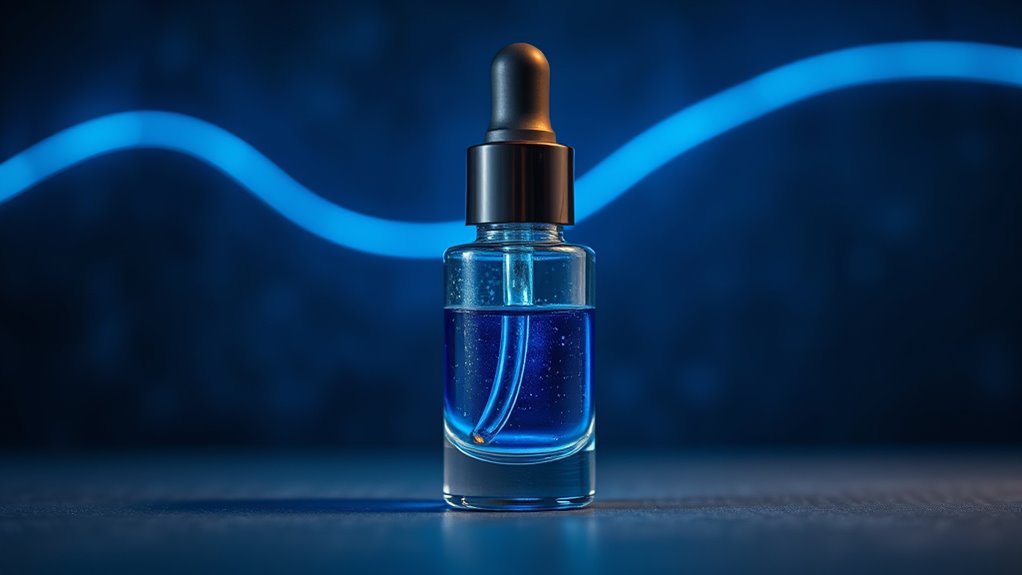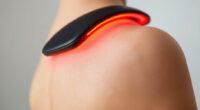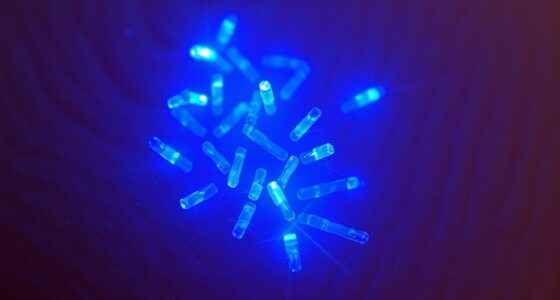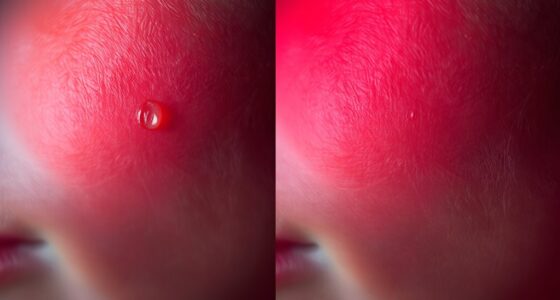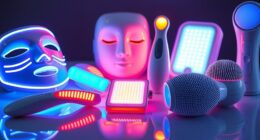Yes, you can use retinoids alongside blue light exposure, but it’s best to protect your skin. Blue light from screens and sunlight can generate free radicals, which might reduce retinoids’ effectiveness and cause skin stress. To optimize benefits, apply retinoids at night, wear sunscreen daily, and incorporate antioxidant-rich products. These protective steps help minimize blue light’s impact while allowing you to enjoy the advantages of retinoids. Keep exploring to discover how to balance skin care and light exposure effectively.
Key Takeaways
- Blue light may cause skin oxidative stress, potentially diminishing retinoids’ benefits, but typical exposure levels are usually low enough not to interfere.
- Applying retinoids at night and using broad-spectrum sunscreen helps protect skin from blue light and enhances retinoid efficacy.
- Using antioxidants in skincare can neutralize free radicals generated by blue light, supporting retinoid benefits.
- Most users can safely combine blue light exposure with retinoids, especially when protective measures like sun protection are in place.
- Ongoing research continues to clarify blue light’s impact, but current evidence supports coexistence with proper skincare practices.

While retinoids are renowned for their skin-renewing benefits, recent research suggests that blue light exposure may impact their effectiveness. If you’re using retinoids as part of your skincare routine, it’s natural to wonder whether exposure to blue light—whether from screens or sunlight—could interfere with their benefits. Blue light, which has a shorter wavelength than other visible light, penetrates deep into the skin and can generate free radicals, potentially leading to skin stress and aging. Some studies imply that this oxidative stress might diminish the collagen-boosting and skin cell turnover effects that retinoids promote.
However, it’s important to understand that the science is still evolving. While laboratory studies indicate that blue light can cause some degree of skin damage, the real-world impact varies depending on exposure levels, duration, and individual skin sensitivity. For most people, daily blue light exposure from screens isn’t significant enough to counteract the benefits of retinoids. Still, if you’re concerned about maximizing their effectiveness, there are practical steps you can take. Using a broad-spectrum moisturizer with antioxidants can help neutralize free radicals generated by blue light, protecting your skin. Applying retinoids at night is also a good idea because it reduces the simultaneous exposure to blue light from screens and natural sunlight, which is more intense during the day.
It’s also worth noting that retinoids themselves can make your skin more sensitive to sunlight, increasing the risk of damage from UV and visible light. That’s why daily sunscreen use is essential, especially if you’re using retinoids regularly. A broad-spectrum sunscreen with at least SPF 30 can shield your skin from both UV rays and some blue light wavelengths. Combining retinoids with antioxidant-rich skincare products further enhances your defense, helping preserve their benefits and maintaining your skin’s overall health. Additionally, understanding the role of light-induced oxidative stress can help you better protect your skin from potential damage.
In essence, while blue light might pose some challenge to the full effectiveness of retinoids, it doesn’t mean you need to abandon your routine. Instead, focus on protecting your skin with antioxidants, proper sun protection, and mindful application timing. Using retinoids at night, limiting unnecessary blue light exposure, and maintaining a detailed skincare routine can help you get the most out of your products without sacrificing your skin’s health. As research continues, staying informed and adjusting your routine accordingly can ensure you enjoy the skin-renewing benefits of retinoids while minimizing potential blue light effects.
Frequently Asked Questions
Can Blue Light Exposure Worsen Retinoid Side Effects?
Yes, blue light exposure can potentially worsen retinoid side effects. When you use retinoids, your skin becomes more sensitive, especially to environmental stressors like blue light. Prolonged exposure might increase irritation, redness, or dryness. To protect your skin, wear broad-spectrum sunscreen during the day, limit screen time when possible, and consider applying calming products to reduce irritation. Always consult your dermatologist for personalized advice.
Are There Specific Retinoids More Compatible With Blue Light Protection?
Certain retinoids, like adapalene, are generally more compatible with blue light protection because they tend to cause less irritation and sensitivity. You should opt for formulations that include soothing ingredients, and consider using a dedicated blue light screen or antioxidant serums to enhance protection. Always consult your dermatologist for personalized advice, especially if you’re combining retinoids with blue light shields or treatments.
How Does Blue Light Affect Retinoid Penetration in Skin?
A stitch in time saves nine, and when it comes to blue light and retinoids, blue light can hinder retinoid absorption by creating a protective barrier on your skin. This barrier reduces penetration, making retinoids less effective. To get the best results, apply retinoids at night and protect your skin from blue light during the day with SPF or blue light filters. This way, you guarantee maximum penetration and skincare benefits.
Is There a Recommended Time to Use Retinoids and Blue Light Protection?
You should apply retinoids at night to maximize their effectiveness and reduce the risk of irritation. During the day, use a broad-spectrum sunscreen with at least SPF 30 to protect your skin from blue light and UV rays. If you’re exposed to blue light frequently, consider wearing blue light blocking glasses or using skincare products formulated to shield against blue light damage. This routine helps keep your skin healthy and protected.
Can I Combine Blue Light Filters With Retinoid Skincare Routines?
Yes, you can combine blue light filters with retinoid skincare routines. Imagine a shield glowing softly over your face, blocking digital blue light while your retinoids work beneath, renewing your skin. Just apply your retinoids at night and wear blue light filters during the day, like a protective armor. This pairing enhances your skincare, keeping your skin resilient and radiant amidst daily screen time challenges.
Conclusion
So, yes, blue light and retinoids can coexist on your skincare stage. Think of them as teammates, each playing a essential role in your skin’s story. Just remember to introduce them thoughtfully—start slow, and always shield your skin with a good moisturizer and sunscreen. With patience and care, you’ll keep your skin’s harmony intact, like a symphony where every instrument plays its part perfectly. Your skin will thank you for the balanced duet.
